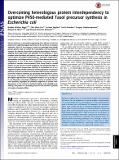| dc.contributor.author | Biggs, Bradley Walters | |
| dc.contributor.author | Lim, Chin Giaw | |
| dc.contributor.author | Sagliani, Kristen | |
| dc.contributor.author | Shankar, Smriti | |
| dc.contributor.author | Stephanopoulos, Gregory | |
| dc.contributor.author | De Mey, Marjan | |
| dc.contributor.author | Ajikumar, Parayil Kumaran | |
| dc.date.accessioned | 2017-01-12T15:45:57Z | |
| dc.date.available | 2017-01-12T15:45:57Z | |
| dc.date.issued | 2016-03 | |
| dc.date.submitted | 2015-08 | |
| dc.identifier.issn | 0027-8424 | |
| dc.identifier.issn | 1091-6490 | |
| dc.identifier.uri | http://hdl.handle.net/1721.1/106355 | |
| dc.description.abstract | Recent advances in metabolic engineering have demonstrated the potential to exploit biological chemistry for the synthesis of complex molecules. Much of the progress to date has leveraged increasingly precise genetic tools to control the transcription and translation of enzymes for superior biosynthetic pathway performance. However, applying these approaches and principles to the synthesis of more complex natural products will require a new set of tools for enabling various classes of metabolic chemistries (i.e., cyclization, oxygenation, glycosylation, and halogenation) in vivo. Of these diverse chemistries, oxygenation is one of the most challenging and pivotal for the synthesis of complex natural products. Here, using Taxol as a model system, we use nature’s favored oxygenase, the cytochrome P450, to perform high-level oxygenation chemistry in Escherichia coli. An unexpected coupling of P450 expression and the expression of upstream pathway enzymes was discovered and identified as a key obstacle for functional oxidative chemistry. By optimizing P450 expression, reductase partner interactions, and N-terminal modifications, we achieved the highest reported titer of oxygenated taxanes (∼570 ± 45 mg/L) in E. coli. Altogether, this study establishes E. coli as a tractable host for P450 chemistry, highlights the potential magnitude of protein interdependency in the context of synthetic biology and metabolic engineering, and points to a promising future for the microbial synthesis of complex chemical entities. | en_US |
| dc.language.iso | en_US | |
| dc.publisher | National Academy of Sciences (U.S.) | en_US |
| dc.relation.isversionof | http://dx.doi.org/10.1073/pnas.1515826113 | en_US |
| dc.rights | Article is made available in accordance with the publisher's policy and may be subject to US copyright law. Please refer to the publisher's site for terms of use. | en_US |
| dc.source | PNAS | en_US |
| dc.title | Overcoming heterologous protein interdependency to optimize P450-mediated Taxol precursor synthesis in Escherichia coli | en_US |
| dc.type | Article | en_US |
| dc.identifier.citation | Biggs, Bradley Walters et al. “Overcoming Heterologous Protein Interdependency to Optimize P450-Mediated Taxol Precursor Synthesis in Escherichia Coli.” Proceedings of the National Academy of Sciences 113.12 (2016): 3209–3214. © 2016 National Academy of Sciences. | en_US |
| dc.contributor.department | Massachusetts Institute of Technology. Department of Chemical Engineering | en_US |
| dc.contributor.mitauthor | Stephanopoulos, Gregory | |
| dc.contributor.mitauthor | De Mey, Marjan | |
| dc.relation.journal | Proceedings of the National Academy of Sciences | en_US |
| dc.eprint.version | Final published version | en_US |
| dc.type.uri | http://purl.org/eprint/type/JournalArticle | en_US |
| eprint.status | http://purl.org/eprint/status/PeerReviewed | en_US |
| dspace.orderedauthors | Biggs, Bradley Walters; Lim, Chin Giaw; Sagliani, Kristen; Shankar, Smriti; Stephanopoulos, Gregory; De Mey, Marjan; Ajikumar, Parayil Kumaran | en_US |
| dspace.embargo.terms | N | en_US |
| dc.identifier.orcid | https://orcid.org/0000-0001-6909-4568 | |
| mit.license | PUBLISHER_POLICY | en_US |
